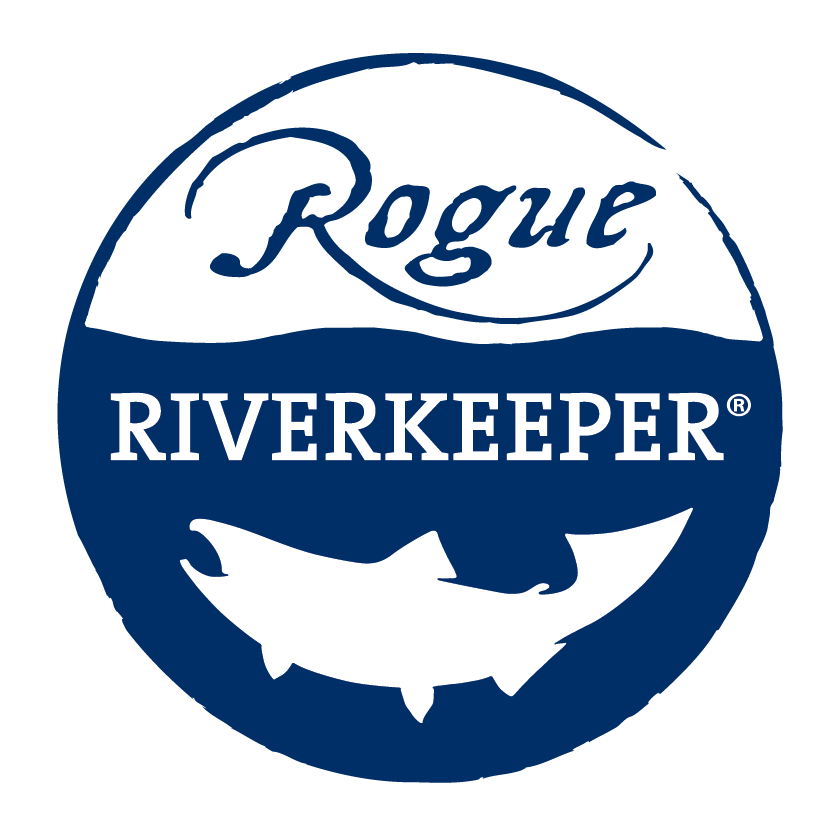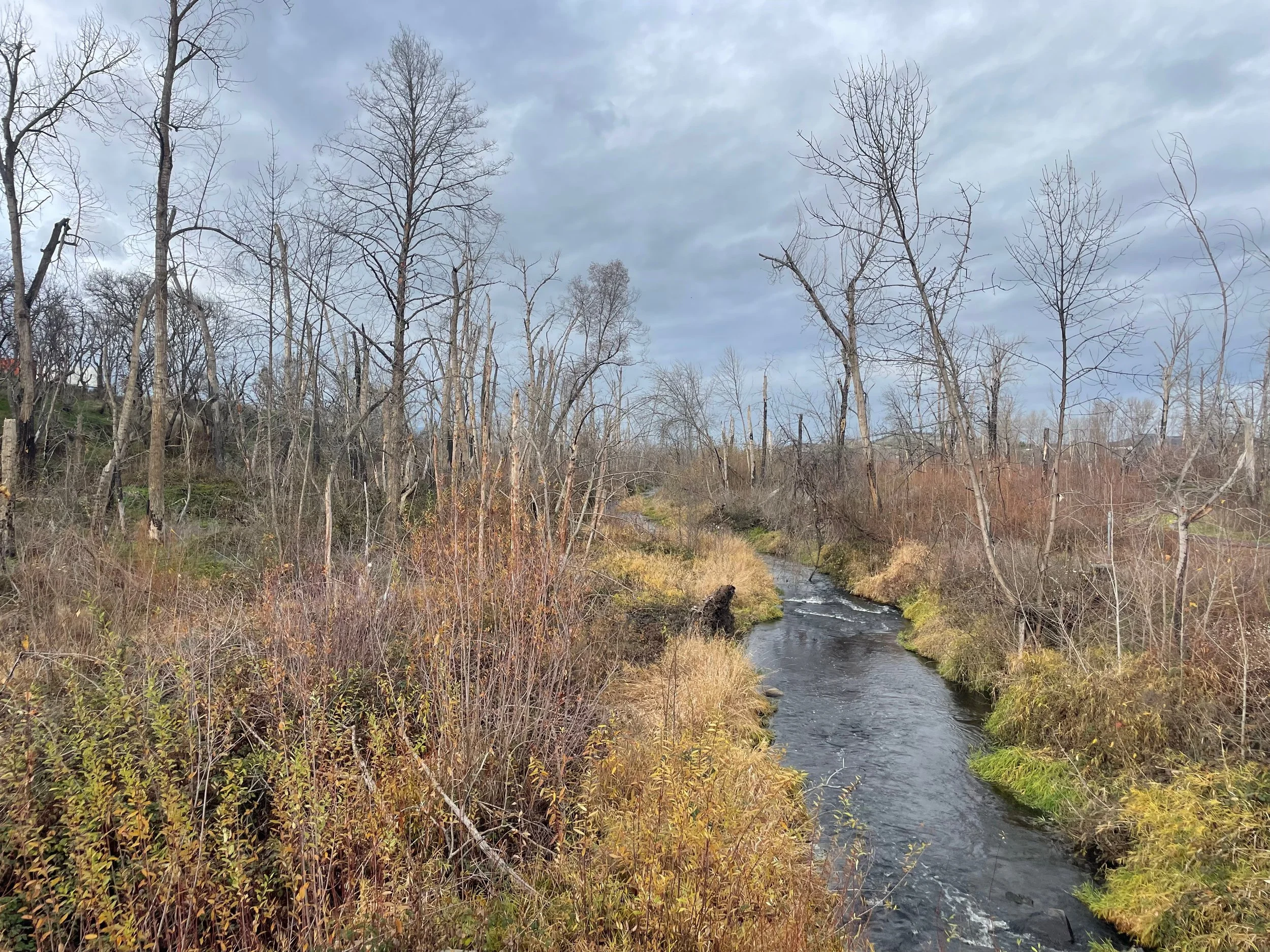Protection of Riparian Habitats Offers Some of Our Best Chances to Protect the Rogue’s Water Quality
What is a riparian area?
Riparian areas are the transition zones between fully aquatic and fully terrestrial habitats, that lush green swath of vegetation that thrives in the wetter conditions alongside freshwater streams, rivers, and lakes. Maintaining the function of these habitats offer some of our best chances to protect water quality in the Rogue. Riparian area function is closely connected to numerous values that we hold dear in the Rogue: native fish, clean water, livability, wildfire prevention, and more. While the riparian habitats in our region are small compared to the size of the basin overall, they can have a big impact on the health of waterways. Watch our video on “What is a riparian area?” here!
Riparian areas are a unique habitat
Riparian habitats are found throughout the world and known for their high biodiversity. Because of the access to water, the plants and animals in riparian areas have an advantage. The riparian plants tend to be lush with broadleaves and provide an abundance of food and shelter for animals of all kinds. In addition, riparian areas also provide many benefits to the water quality of the waterways they line. The physical and biological components of a riparian area and and associated floodplain work together to create a protective buffer along the edge of the water: the low gradient combined with the structures of the plants and substrate of the riparian floodplain physically hold sediment and pollutants to keep them from entering the stream or river where it can cause harm to living organisms. Additionally, these habitats also act as sponges to store and release water seasonally.
Riparian benefits to water quality and aquatic habitats
Riparian area along Bear Creek. Photo: Frances Oyung
Beyond the physical actions of filtering pollutants, a multistory canopy of mature native trees and shrubs shades streams to help keep stream water cool, critical to the native fish and other aquatic organisms in the Rogue. Native fish including Chinook salmon, lamprey, resident trout, steelhead, and threatened coho are present in the Rogue basin and require cold water to thrive and compete with introduced fish like redside shiners, pikeminnow and fathead minnows. Thriving riparian areas are directly correlated to supporting native fish populations. Development on urban and agricultural land and the removal or degradation of riparian areas are some the biggest threats to riparian areas and the benefits they provide.
Large trees in riparian areas provide habitat even when they die. The standing dead snags provide habitat to cavity-nesting birds and woody debris falling into streams slows the flow of water and provides fish a place to hold in the current. Large wood in streams provide structures to slow water that allow for gravel collection to provide spawning habitat for fish. Without structures to help hold gravel, there is nowhere for fish to spawn. No gravel to spawn in means no young salmon.
Leaf matter from riparian areas falling into streams and rivers feed the small organisms, the macroinvertebrates, that young salmon feed on. If there is nothing for the macroinvertebrates to eat, there is less food for young salmon to eat. Degradation of riparian areas degrades the associated aquatic ecosystems of the Rogue.
Other benefits of protecting riparian areas
The protection of native trees and understory shrubs and the reduction of invasive species like blackberry provides multiple ecological benefits outside of the adjacent aquatic habitats. Riparian area protection supports diverse wildlife that people enjoy along the greenway. Along the heavily urbanized Bear Creek Greenway, bird counts by members of the Rogue Valley Audubon Society have found >130 bird species using riparian and floodplain habitat along the Greenway. The vegetation in riparian areas support beavers and allows these keystone animals to do valuable ecological work in waterways. Beavers are present in many parts of the Rogue basin, including the urbanized streams.
Riparian areas must be functioning
While there is a high degree of concern over the flammability of plants in riparian areas, we need to be cautious when removing plants and even dead snags. Functioning multi-species riparian areas with a strong component of native plants have been shown to be more fire-resistant and wildfire resilient than riparian areas with heavy blackberry growth with years of accumulated dry canes. The need for a robust ecologically functioning riparian area is becoming even more critical for their numerous ecological and water quality reasons as weather becomes more extreme and we see hotter summers in the valley. Allowing riparian areas to hold water in the ground and in their leaves provides a buffer to fire and is not prone to accelerating wildfire.
In order to allow riparian areas to function in perpetuity, it is important to allow young native plants to germinate and mature. To get the highest benefit to water quality, trees need to grow large and tall to reach out over streams. Protection of native trees and understory shrubs along the Rogue River and its tributaries by local cities and other agencies is one way that those jurisdictions meet their water quality goals set with the OR Dept. of Environmental Quality as required under the Clean Water Act. Being in compliance with the Clean Water Act means working towards improving the conditions of streams as it relates to temperature, sediment, nutrients, and other pollutants. That means supporting, protecting, and maintaining high quality riparian areas. If we seek the benefits of riparian areas in the Rogue, there is more to making these habitats functional than planting a tree. It is vital that on-the-ground maintenance as well as planning, development, and code enforcement reflect an understanding of the ecological system being impacted and a compliance with the permits, regulations, and state recommendations to protect and enhance riparian areas.
Riparian areas post-fire
Bear Creek in Talent, OR after the Almeda Fire. Photo: Haleigh Martin
After the fires of 2020 that burned hot through the dry blackberry canes built up over the decades, residents have intense concerns about wildfire in vegetated areas. What has been determined through study and research is that native vegetation in riparian area can also serve as a buffer to wildfire, provided that the habitat is lush native vegetation and not dry blackberry canes. Fuel reduction in riparian areas does not mean eliminating all woody plants except for a few large trees along streams. The water-loving vegetation making up riparian areas can serve as a fuel buffer, holding water within its leaves and in the soil to reduce flammability.
Protection and enhancement of beaver habitat to increase the presence of these beneficial animals will increase and enhance the ability and function of the spongelike water-holding capacity of floodplains and riparian areas. Allowing and encouraging beavers on the landscape promotes a healthy and fire resistant and resilient riparian forest.
The protection of riparian areas and ecosystem services found in these habitats have a high cumulative benefits to water quality in the Rogue basin.
Why this matters to Rogue Riverkeeper:
Rogue Riverkeeper stands as a water quality advocate in the Rogue basin and riparian areas, those green swaths alongside freshwater bodies, are critical for providing shade and filtration and storage of groundwater as well as habitat among numerous other ecological and water quality benefits. Rogue Riverkeeper works on many aspects of protecting riparian areas, from advocating for the protection of beavers, to pushing for holistic vegetation management by agencies.
How local cities and counties implement and enforce riparian protections (of which most have in some form) are challenging to monitor as there are so many activities by numerous parties that impact riparian areas. Private and public landowners carry on vegetation removal and earth moving in riparian areas with various levels of compliance to even their own regulations.
A proposed parks plan by the City of Central Point has the potential to have an impact on the riparian area along a 1 mile section of Bear Creek and Rogue Riverkeeper wants to make sure that the city parks planners and city government officials know that long-term protection and ecological management of riparian areas are critical to their function and overall water quality benefits. This section of Bear Creek is heavily used for salmon spawning and after the fire in 2020, in great need of restoration and long term ecological management.
At a meeting on Feb. 15 before the City of Central Point Parks Commission, the OR Dept. of Fish & Wildlife and Rogue Riverkeeper requested that riparian and floodplain stewardship be written in and included as an objective in the Central Point Greenway Master Plan. The Parks Commission voted to recommend the parks master plan along with an addition to include stewardship be included in the park plan.
Rogue Riverkeeper has been meeting alongside other advocates including the OR Dept. of Fish & Wildlife to review the riparian ordinance and its implementation and enforcement in the City of Ashland and we look forward to working with the City to see adjustments to their code to be more protective of riparian habitats and water quality. We have also been in conversation with Jackson County Parks Department as it implements a project along Bear Creek to reduce fuels and improve access for long-term maintenance as well as safety along the Greenway. Yes, there are many interests and goals regarding work in riparian areas, but striking the balance between protecting water quality and a functional riparian area can include a fire-safe and resilient landscape as well as improvements to water quality.
Riparian and floodplain stewardship requires a clear understanding and acceptance of the importance of riparian function at all levels of implementation including the long-term maintenance of riparian areas. Rogue Riverkeeper will continue to advocate for stewardship that establishes setbacks and buffers around the Rogue River and tributaries and protects native trees and shrubs to create a diverse, complex, and ecologically functioning riparian areas for the long-term.
Where to find out more about riparian restoration and maintenance:
The Jackson Soil & Water Conservation District. This SWCD has staff and a website that can point you in the right direction of design, materials, and possibly funding assistance.
The Rogue Valley Council of Governments has a Natural Resources Dept. that has some resources and a website with regionally specific information.
There are several watershed councils in the Rogue basin that all do various types of riparian restoration and may be able to provide assistance to local landowners.
Rogue Valley Sewer Services has a list of sources for native plants.
In most of the Rogue basin, landowners seeking to do vegetation removal or restoration in a riparian area need to have a plan approved by the OR Dept. of Fish & Wildlife prior to beginning work. Contact a local ODFW office to set up an appointment.
ODFW Central Point Rogue Watershed District Office
1495 E. Gregory Road
Central Point, OR 97502
Tel: 541-826-8774
Gold Beach Field Office
29907 Airport Way, PO Box 642
Gold Beach, OR 97444
Tel: 541-247-7605



